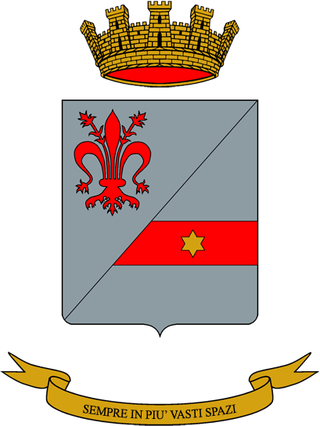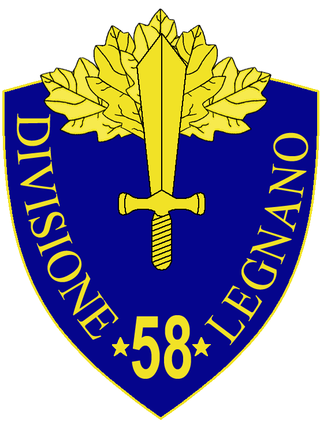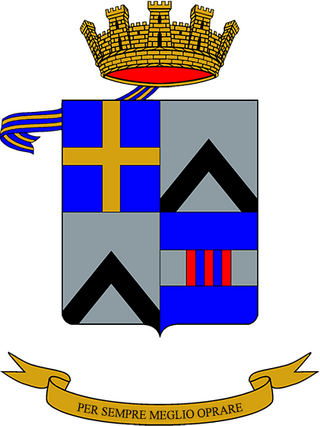
The 2nd Alpine Signal Regiment is an expeditionary signals regiment of the Italian Army based in Bolzano in South Tyrol that specializes in mountain warfare. Since 1951, the unit has been assigned of the 4th Alpine Army Corps and has therefore a strong association with the Italian Army's mountain infantry speciality, the Alpini, with whom the regiment shares the distinctive Cappello Alpino. The unit was first active from 1926 to 1932 as 2nd Radio-Telegraphers Regiment.

The Lagunari Regiment "Serenissima" is the active unit of Italian Army's infantry arm's amphibious Lagunari speciality. The name of the speciality comes from the Italian word for lagoon, while the regiment's name "Serenissima" commemorates the Most Serene Republic of Venice. The regiment is based in Venice and assigned to the Cavalry Brigade "Pozzuolo del Friuli". The "Pozzuolo del Friuli" brigade forms, together with the Italian Navy's Third Naval Division and San Marco Marine Brigade, the Italian Armed Forces' Sea Projection Force.
On March 1, 1984 the Italian Institute for Disarmament, Development and Peace (Istituto di ricerche per il disarmo, lo sviluppo e la pace in Rome published the entire Italian Army order of battle down to company level – this was justified by the radical party as one of its core demands was total disarmament of Europe, even though the data which was published was top secret. The Radical Party dissolved in 1989 and the IRDISP followed suit in 1990. But Radio Radicale has survived, and the OrBat can still be found today on the homepage of the radio.

The 11th Infantry Division "Brennero" was a infantry division of the Royal Italian Army during World War II. The Brennero was classified as a mountain infantry division, which meant that the division's artillery was moved by pack mules instead of the horse-drawn carriages of line infantry divisions. Italy's real mountain warfare divisions were the six alpine divisions manned by Alpini mountain troops. The Brennero was named for the Brenner Pass between Italy and Austria. The division was based in the western half of South Tyrol with the division's headquarter in Bolzano.

The 58th Infantry Division "Legnano" was an infantry division of the Royal Italian Army during World War II. The Legnano's predecessor division was formed on 8 February 1934 in Milan and named for the medieval Battle of Legnano. On 24 May 1939 the division split to form the 6th Infantry Division "Cuneo" and the 58th Infantry Division "Legnano". After the announcement of the Armistice of Cassibile the Legnano resisted the invading German forces. The division's staff and 67th Infantry Regiment "Legnano" were used to form the first unit of the Italian Co-belligerent Army, which fought on the allied side in the Italian campaign. On 17 February 1944 the division's last units joined other commands and the division was officially dissolved.

After World War II the Italian Army had two units named "Centauro": from 1952 to 1986 the Armored Division "Centauro" and from 1986 to 2002 the Armored Brigade "Centauro". Both units were successor to the World War II era 131st Armored Division "Centauro". The units' name came from the mythological race of half human-half horse creatures named Centaurs.

The Mechanized Brigade "Mantova" was a mechanized brigade of the Italian Army. Its core units were mechanized infantry battalions. The brigade's headquarters was in the city of Cividale del Friuli and all the brigade's units were based in the region of Friuli-Venezia Giulia. In 2003, the "Mantova" was raised again as a division command.

The Mechanized Brigade "Legnano" was a mechanized brigade of the Italian Army. Its core units were mechanized infantry battalions. The brigade's headquarters was in the city of Bergamo in Lombardy. The name of the brigade commemorates the Lombard League victory in the Battle of Legnano in 1176 and its coat of arms depicts the Monument to the Warrior of Legnano in the centre of Legnano.
The following is a hierarchical outline for the Italian Army at the end of the Cold War. It is intended to convey the connections and relationships between units and formations.
With the 1975 reforms the Italian Army abolished the regimental level and replaced it with brigades made up of multiple arms. During the reform the army disbanded 48 regimental commands and reduced its force by 87 battalions. A further ten regimental commands were used to raise ten new brigade commands. Ten training centers, which for traditional reasons had carried the names of regiments, were also disbanded. The reduction in units also allowed to mechanize most of the remaining units in Northern Italy and Italy's defense strategy changed from a hold-at-all-costs territorial defense to one of mobile warfare.

Italian Army gorget patches are worn by all army personnel on the collars of the shirts and jackets of their service uniforms and formal uniforms. The gorget patches identify the arm, corps, or speciality within an arm or corps a soldier belongs to. Generals wear golden stars instead of a gorget patches, while army recruits wear silver stars until they are assigned to a unit after basic training. Originally made from colored cloth, respectively embroidered cloth for Granatieri, Carabinieri and general staff members, gorget patches have been made since 1973 from enamelled metal.

The 232nd Signal Regiment is an expeditionary signals regiment of the Italian Army based in Avellino in Campania. The unit was formed in 1958 as a battalion and assigned to the Armored Division "Ariete". In 1975, the battalion was named for the Sella di Fadalto Pass and received the number 232nd, which had been used by the 232nd Connections Company that had served with the 132nd Armored Division "Ariete" during the Western Desert campaign of World War II. With the name and number the battalion also received its own flag. In 1991, the battalion was disbanded. In 2004, the unit was reformed as 232nd Signal Regiment. Initially the regiment consisted only of the Signal Battalion "Legnano", but in 2015 the regiment reformed the Signal Battalion "Fadalto" as its second signal battalion. The regiment is assigned to the army's Signal Command and affiliated with the Division "Acqui". The regiment's anniversary falls, as for all signal units, on 20 June 1918, the day the Austro-Hungarian Army began its retreat across the Piave river during the Second Battle of the Piave River.

The 7th Signal Regiment is an expeditionary signals regiment of the Italian Army based in Sacile in Friuli-Venezia Giulia. In 1918, during World War I, the regiment was formed as 7th Engineer Regiment (Telegraphers) with 59 companies transferred from the 3rd Engineer Regiment (Telegraphers). In 1920, the regiment was disbanded and its companies formed into battalions, which were assigned to the Royal Italian Army's army corps.

The 1st Signal Regiment is an expeditionary signals regiment of the Italian Army based in Milan in Lombardy. The unit was formed in 1906 in Rome as a detached brigade of the 3rd Engineer Regiment (Telegraphers) and tasked with training the army's wireless telegraphy personnel. In 1919, the battalion was expanded to Radio-Telegraphers Engineer Regiment, which split in 1926 to form the 1st Radio-Telegraphers Regiment and 2nd Radio-Telegraphers Regiment. Both regiment were disbanded in 1932.

The 3rd Signal Regiment is a national support signals regiment of the Italian Army based in Rome in Lazio. The regiment is the army's oldest signal regiment and assigned to the army's Signal Command. The regiment's three battalions operate the army's telecommunications network in central Italy and Sardinia. The regiment was formed in 1883 as an engineer regiment, which, in 1895, became responsible for training the Royal Italian Army's telegraph personnel and for providing telegraph units to operational units. In 1912, the regiment added the training of wireless telegraphy personnel to its duties. During World War I the regiment formed a total of 127 companies, 59 of which were transferred in 1918 to the newly formed 7th Engineer Regiment (Telegraphers). In 1920, the regiment was disbanded and its companies formed into battalions, which were assigned to the Royal Italian Army's army corps.

The 184th TLC Support Battalion "Cansiglio" is a telecommunications (TLC) support battalion of the Italian Army's signal corps. The battalion is based in Treviso in Veneto and assigned to the Army Logistic Command. The unit was formed in 1947 as a battalion and assigned to the Infantry Division "Folgore". In 1976, the battalion was named for the Cansiglio Pass and received the number 184th, which had been used by the 184th Connections Company that had served with the 184th Infantry Division "Nembo" and the Combat Group "Folgore" during the Italian campaign of World War II. With the name and number the battalion also received its own flag. In 1993, the battalion was disbanded and its personnel used to form the Signals Materiel Repair, Supply and Experimentation Telematic Center. In 1999, the center was renamed 184th TLC Support Regiment, which received the flag and traditions of the battalion. Since then, the unit is responsible for building and maintaining the army's telecommunications network in northern Italy and Tuscany, and for providing third line maintenance for the network's materiel in the aforementioned regions. In 2017, the regiment was disbanded and the battalion became once more an autonomous unit. The battalion's anniversary falls, as for all signal units, on 20 June 1918, the day the Austro-Hungarian Army began its retreat across the Piave river during the Second Battle of the Piave River.

The 231st Signal Battalion "Sempione" is signals unit of the Italian Army. The battalion was formed in 1959 and assigned to the Armored Division "Centauro". In 1975, the battalion was named for the Simplon Pass and received the number 231st, which had been used by the 231st Connections Company that had served with the 131st Armored Division "Centauro" during the Tunisian campaign of World War II. With the name and number the battalion also received its own flag. In 1991, the battalion was disbanded. In 2001, the battalion was reformed and assigned to the 1st Signal Regiment as the regiment's second signal battalion. The battalion's anniversary falls, as for all signal units, on 20 June 1918, the day the Austro-Hungarian Army began its retreat across the Piave river during the Second Battle of the Piave River.

The 107th Signal Battalion "Predil" is a signals unit of the Italian Army. The battalion was formed in 1946 and assigned to the Infantry Division "Mantova". In 1975, the battalion was named for the Predil Pass and received the number 107th, which had been used by the 107th Teleradio Company that had served with the Combat Group "Mantova" during the Italian campaign of World War II. With the name and number the battalion also received its own flag. In 1991, the battalion was disbanded. In 2002, the battalion was reformed and assigned to the 7th Signal Regiment as the regiment's second signal battalion. The battalion's anniversary falls, as for all signal units, on 20 June 1918, the day the Austro-Hungarian Army began its retreat across the Piave river during the Second Battle of the Piave River.

The 51st Engineer Battalion "Simeto" is a military engineering unit of the Italian Army last based in Palermo in Sicily. During the later half of World War I the Royal Italian Army's 2nd Engineer Regiment (Sappers) formed an engineer battalion with the number LI, which served on the Italian Front. In 1935, in preparation for the Second Italo-Ethiopian War, the 4th Engineer Regiment formed an engineer battalion, which received the same number. After the annexation of Ethiopia the battalion remained active and served in the Western Desert campaign and Tunisian campaign of World War II. In 1943, the Italian Co-belligerent Army formed an engineer battalion with the number LI, which was initially assigned to the I Motorized Grouping, then the Italian Liberation Corps, and finally the Combat Group "Legnano". The battalion fought on the allied side in the war's Italian campaign.

The 231st Infantry Regiment "Avellino" is an inactive infantry unit of the Italian Army. The regiment is named for the southern Italian city of Avellino and part of the Italian Army's infantry arm.
















